Clutch YAMAHA MT-10 2020 Owners Manual
[x] Cancel search | Manufacturer: YAMAHA, Model Year: 2020, Model line: MT-10, Model: YAMAHA MT-10 2020Pages: 108, PDF Size: 9.22 MB
Page 6 of 108

Table of contentsSafety information........................... 1-1
Description ....................................... 2-1
Left view ......................................... 2-1
Right view ....................................... 2-2
Controls and instruments................ 2-3
Special features ............................... 3-1
Cruise control system ..................... 3-1
D-mode (drive mode)...................... 3-3
Traction control system .................. 3-4
Quick shift system ...... .................... 3-6
Instrument and control
functions ........................................... 4-1
Immobilizer system ..... .................... 4-1
Main switch/steering lock................ 4-2
Handlebar switches ........................ 4-3
Indicator lights and warning lights ............................................ 4-5
Multi-function meter unit ................. 4-8
Clutch lever................................... 4-16
Shift pedal..... ............................ .... 4-16
Brake lever ................................... 4-16
Brake pedal .................................. 4-17
ABS .............................................. 4-17
Fuel tank cap ................................ 4-18
Fuel............................................... 4-19
Fuel tank overflow hose................ 4-21
Catalytic converter ........................ 4-21
Seat .............................................. 4-22 Adjusting the front fork ................. 4-22
Adjusting the shock absorber
assembly................................... 4-24
Luggage strap holders . ................ 4-27
EXUP system ............................... 4-27
Auxiliary DC jack .......................... 4-27
Sidestand ..................................... 4-28
Ignition circuit cut- off system ........ 4-29
For your safety – pre-operation
checks .............................................. 5-1
Operation and important riding
points ................................................ 6-1
Starting the engine ......................... 6-1
Shifting ........................................... 6-2
Tips for reducing fuel consumption ............................... 6-3
Engine break-in .............................. 6-3
Parking ........................................... 6-4
Periodic maintenance and
adjustment ....................................... 7-1
Tool kit............................................ 7-2
Periodic maintenance charts .......... 7-3
Periodic maintenance chart for the emission control system ....... 7-3
General maintenance and
lubrication chart .......................... 7-5
Checking the spark plugs ............... 7-9
Canister ........................................ 7-10 Engine oil ..................................... 7-10
Why Yamalube ............................ 7-14
Coolant ........................................ 7-14
Air filter element ........................... 7-15
Checking the engine idling
speed............ ............................ 7-16
Checking the throttle grip free play ........................................... 7-16
Valve clearance ........................... 7-16
Tires ............................................. 7-17
Cast wheels ................................. 7-19
Adjusting the clutch lever free play ........................................... 7-19
Checking the brake lever free
play ........................................... 7-20
Brake light switches ..................... 7-21
Checking the front and rear
brake pads................................ 7-21
Checking the brake fluid level ...... 7-22
Changing the brake fluid .............. 7-23
Drive chain slack.......................... 7-23
Cleaning and lubricating the drive chain ................................ 7-24
Checking and lubricating the cables ....................................... 7-25
Checking and lubricating the throttle grip and cable ............... 7-25
Checking and lubricating the
brake and shift pedals .............. 7-26
Checking and lubricating the brake and clutch levers ............ 7-26B67-9-E4.book 1 ページ 2019年7月19日 金曜日 午後4時23分
Page 15 of 108
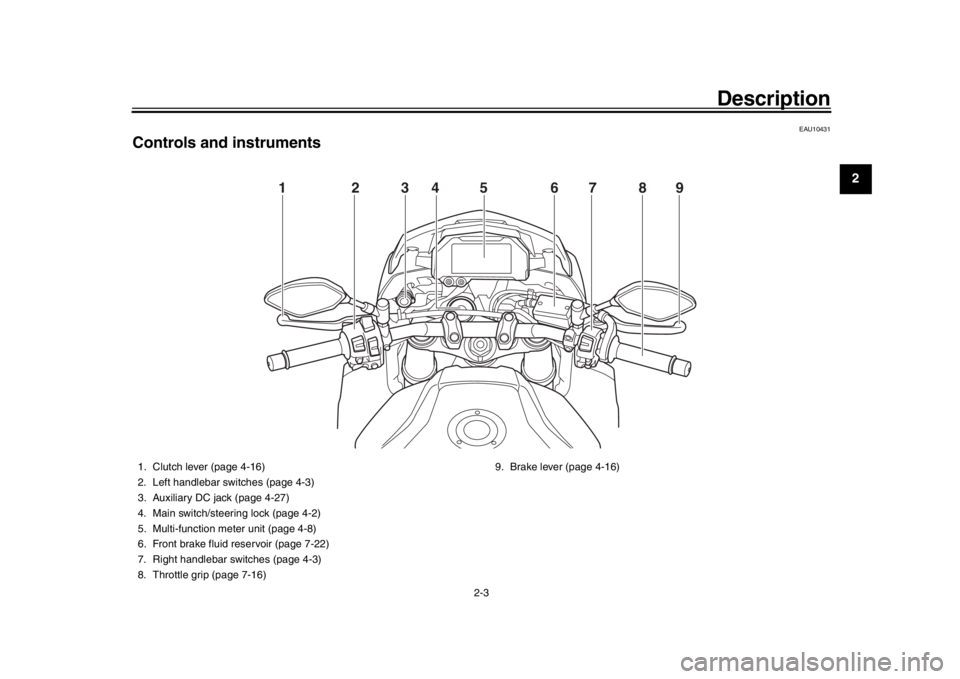
Description
2-3
123
4
5
6
7
8
9
10
11
12
EAU10431
Controls and instruments
12 456789
3
1. Clutch lever (page 4-16)
2. Left handlebar switches (page 4-3)
3. Auxiliary DC jack (page 4-27)
4. Main switch/steering lock (page 4-2)
5. Multi-function meter unit (page 4-8)
6. Front brake fluid reservoir (page 7-22)
7. Right handlebar switches (page 4-3)
8. Throttle grip (page 7-16) 9. Brake lever (page 4-16)
B67-9-E4.book 3 ページ 2019年7月19日 金曜日 午後4時23分
Page 17 of 108

Special features
3-2
1
234
5
6
7
8
9
10
11
12
new cruising speed by pushing the
“SET–” side of the setting switch. If you
do not set a new cruising speed, when
you return the throttle grip, the vehicle
will decelerate to the previously set
cruising speed.
Deactivating the cruise control sys-
tem
Perform one of the following operations
to cancel the set cruising speed. The
“SET” indicator light will go off.
Turn the throttle grip past the
closed position in the deceleration
direction.
Apply the front or rear brake.
Disengage the clutch. Push the power switch to turn off the
cruise control system. The “ ” indica-
tor light and the “SET” indicator light will
go off.
TIPTraveling speed decreases as soon as
the cruise control system is deactivat-ed; unless the throttle grip is turned.
Using the resume function
Push the “RES+” side of the cruise con-
trol setting switch to reactivate the
cruise control system. The traveling
speed will return to the previously set
cruising speed. The “SET” indicator
light will come on.
WARNING
EWA16351
It is dangerous to use the resume
function when the previously set
cruising speed is too high for cur-rent conditions.TIPPushing the power switch while the
system is operating will turn the system
off completely and erase the previously
set cruising speed. You will not be able to use the resume function until a new
cruising speed has been set.
Automatic deactivation of the cruisecontrol systemThe cruise control system for this mod-
el is electronically controlled and is
linked with the other control systems.
The cruise control system will automat-
ically become deactivated under the
following conditions:
The cruise control system is not
able to maintain the set cruising
speed.
Wheel slip or wheel spin is detect-
ed. (If the traction control system
has not been turned off, the trac-
tion control system will work.)
The start/engine stop switch is set
to the “ ” position.
The engine stalls.
The sidestand is lowered.
When traveling with a set cruising
speed, if the cruise control system is
deactivated under the above condi-
tions, the “ ” indicator light will go off
and the “SET” indicator light will flash
for 4 seconds, and then go off.
1. Deceleration direction
1
B67-9-E4.book 2 ページ 2019年7月19日 金曜日 午後4時23分
Page 21 of 108
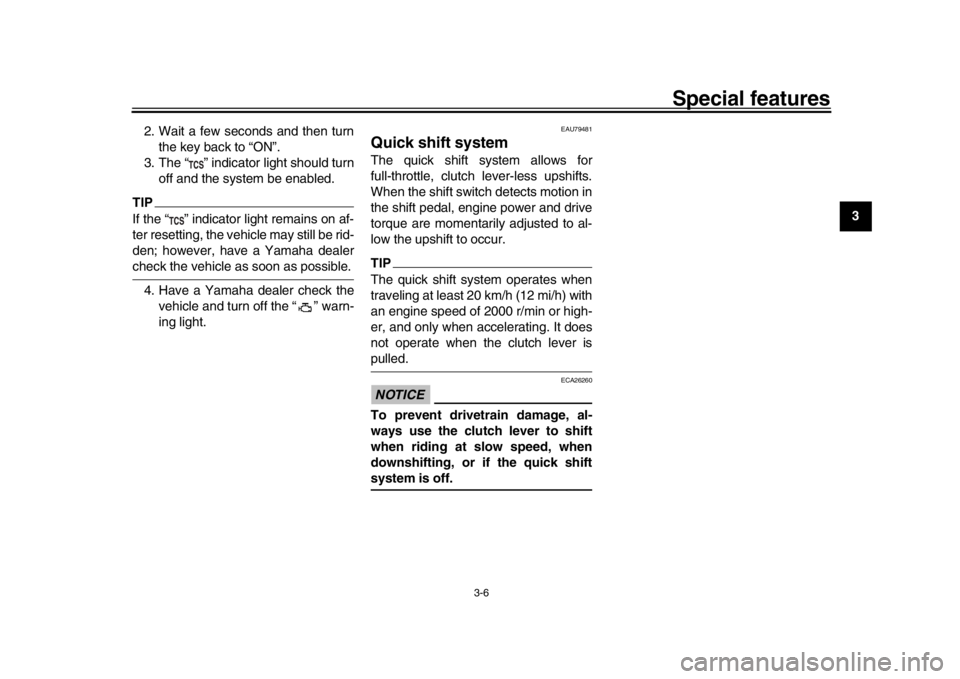
Special features
3-6
1
234
5
6
7
8
9
10
11
12
2. Wait a few seconds and then turn
the key back to “ON”.
3. The “ ” indicator light should turn off and the system be enabled.
TIPIf the “ ” indicator light remains on af-
ter resetting, the vehicle may still be rid-
den; however, have a Yamaha dealercheck the vehicle as soon as possible.
4. Have a Yamaha dealer check the vehicle and turn off the “ ” warn-
ing light.
EAU79481
Quick shift systemThe quick shift system allows for
full-throttle, clutch lever-less upshifts.
When the shift switch detects motion in
the shift pedal, engine power and drive
torque are momentarily adjusted to al-
low the upshift to occur.TIPThe quick shift system operates when
traveling at least 20 km/h (12 mi/h) with
an engine speed of 2000 r/min or high-
er, and only when accelerating. It does
not operate when the clutch lever ispulled.NOTICE
ECA26260
To prevent drivetrain damage, al-
ways use the clutch lever to shift
when riding at slow speed, when
downshifting, or if the quick shiftsystem is off.
B67-9-E4.book 6 ページ 2019年7月19日 金曜日 午後4時23分
Page 37 of 108
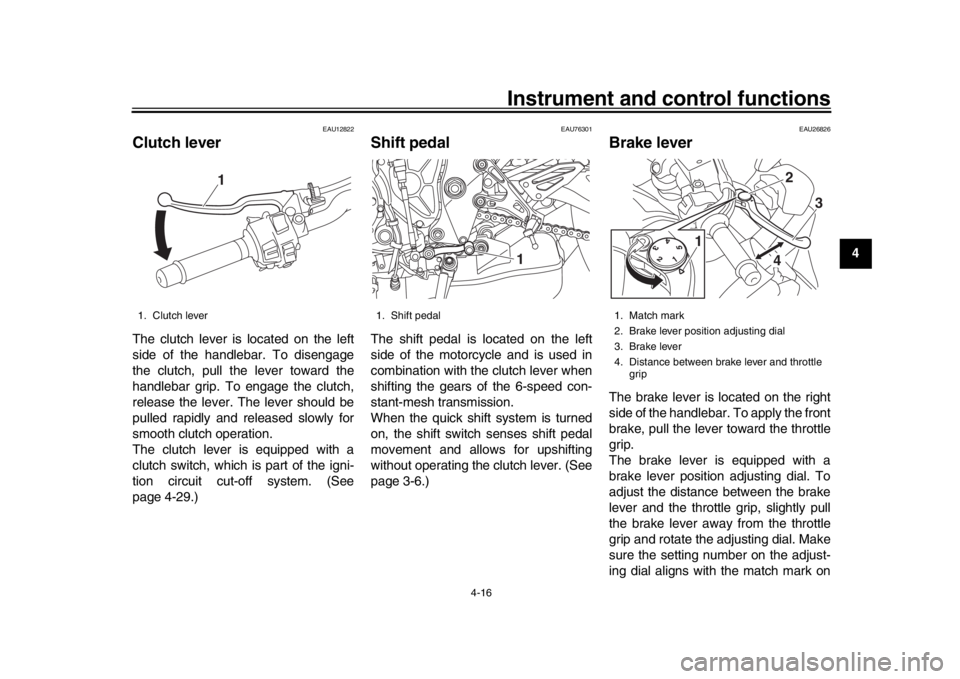
Instrument and control functions
4-16
1
2
345
6
7
8
9
10
11
12
EAU12822
Clutch leverThe clutch lever is located on the left
side of the handlebar. To disengage
the clutch, pull the lever toward the
handlebar grip. To engage the clutch,
release the lever. The lever should be
pulled rapidly and released slowly for
smooth clutch operation.
The clutch lever is equipped with a
clutch switch, which is part of the igni-
tion circuit cut-off system. (See
page 4-29.)
EAU76301
Shift pedalThe shift pedal is located on the left
side of the motorcycle and is used in
combination with the clutch lever when
shifting the gears of the 6-speed con-
stant-mesh transmission.
When the quick shift system is turned
on, the shift switch senses shift pedal
movement and allows for upshifting
without operating the clutch lever. (See
page 3-6.)
EAU26826
Brake leverThe brake lever is located on the right
side of the handlebar. To apply the front
brake, pull the lever toward the throttle
grip.
The brake lever is equipped with a
brake lever position adjusting dial. To
adjust the distance between the brake
lever and the throttle grip, slightly pull
the brake lever away from the throttle
grip and rotate the adjusting dial. Make
sure the setting number on the adjust-
ing dial aligns with the match mark on
1. Clutch lever
1
1. Shift pedal
1
1. Match mark
2. Brake lever position adjusting dial
3. Brake lever
4. Distance between brake lever and throttle grip
4
1 2
3
B67-9-E4.book 16 ページ 2019年7月19日 金曜日 午後4時23分
Page 50 of 108

Instrument and control functions
4-29
1
2
34
5
6
7
8
9
10
11
12
EAU57952
Ignition circuit cut-off systemThis system prevents in-gear engine
starts unless the clutch lever is pulled
and the sidestand is up. Also, it will stop
the running engine should the sides-
tand be lowered while the transmission
is in gear.
Periodically check this system via the
following procedure.TIP
This check is most reliable if per-
formed with a warmed-up engine.
See pages 4-2 and 4-3 for switchoperation information.
B67-9-E4.book 29 ページ 2019年7月19日 金曜日 午後4時23分
Page 51 of 108

Instrument and control functions
4-30
1
2
345
6
7
8
9
10
11
12
With the engine turned off:
1. Move the sidestand down.
2. Set engine stop s witch to run position.
3. T urn m ain switch to on position.
4. Shift tr ansmission into neutr al.
5. Push the start switch.
Does the engine start?
With the engine still r unning:
6. Move the sidestand up.
7. Pull the clutch lever.
8. Shift tr ansmission into gear.
9. Move the sidestand down.
Does the en gine stall?
After the engine has stalled:
10.
Move the sidestand up.
11. Pull the clutch lever.
12. Push the start switch.
Does the engine start?
The system is OK. The motorcycle can be ridden.
YES NO
YES
NO
YES
NO
The neutral switch ma y not be working.
The motorcycle should not be ridden until
checked b y a Yamaha dealer.
The clutch s witch may not be working.
The motorcycle should not be ridden until
checked b y a Yamaha dealer.The sidestand s witch may not be working.
The motorcycle should not be ridden until
checked b y a Yamaha dealer.If a malfunction is found, have the vehicle
inspected before riding.
WARNING
B67-9-E4.book 30 ページ 2019年7月19日 金曜日 午後4時23分
Page 53 of 108

For your safety – pre-operation checks
5-2
1
2
3
456
7
8
9
10
11
12
Rear brake Check operation.
If soft or spongy, have Yamaha dealer bleed hydraulic system.
Check brake pads for wear.
Replace if necessary.
Check fluid level in reservoir.
If necessary, add specified brake fluid to specified level.
Check hydraulic system for leakage. 7-21, 7-22
Clutch Check operation.
Lubricate cable if necessary.
Check lever free play.
Adjust if necessary. 7-19
Throttle grip Make sure that operation is smooth.
Check throttle grip free play.
If necessary, have Yamaha dealer adjust th
rottle grip free play and lubricate cable
and grip housing. 7-16, 7-25
Control cables Make sure that operation is smooth.
Lubricate if necessary. 7-25
Drive chain Check chain slack.
Adjust if necessary.
Check chain condition.
Lubricate if necessary. 7-23, 7-24
Wheels and tires Check for damage.
Check tire condition and tread depth.
Check air pressure.
Correct if necessary. 7-17, 7-19
Brake and shift pedals Make sure that operation is smooth.
Lubricate pedal pivoting points if necessary. 7-26
Brake and clutch levers Make sure that operation is smooth.
Lubricate lever pivoting points if necessary. 7-26
Sidestand Make sure that operation is smooth.
Lubricate pivot if necessary. 7-27
Chassis fasteners Make sure that all nuts, bolts and screws are properly tightened.
Tighten if necessary. —
ITEM CHECKS PAGE
B67-9-E4.book 2 ページ 2019年7月19日 金曜日 午後4時23分
Page 55 of 108
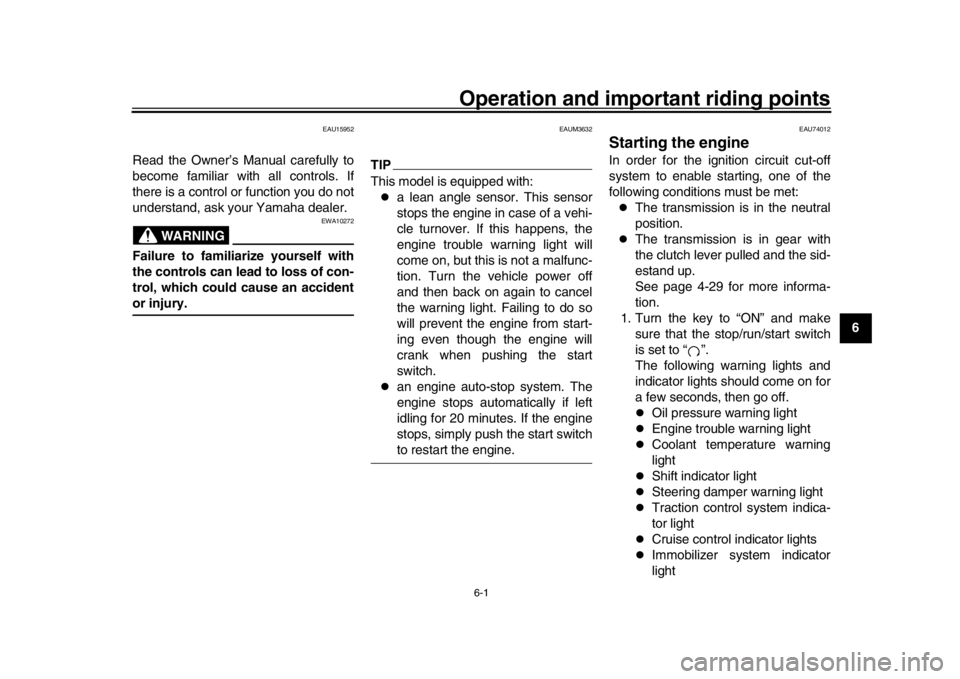
6-1
1
2
3
4
567
8
9
10
11
12
Operation and important riding points
EAU15952
Read the Owner’s Manual carefully to
become familiar with all controls. If
there is a control or function you do not
understand, ask your Yamaha dealer.
WARNING
EWA10272
Failure to familiarize yourself with
the controls can lead to loss of con-
trol, which could cause an accidentor injury.
EAUM3632
TIPThis model is equipped with:
a lean angle sensor. This sensor
stops the engine in case of a vehi-
cle turnover. If this happens, the
engine trouble warning light will
come on, but this is not a malfunc-
tion. Turn the vehicle power off
and then back on again to cancel
the warning light. Failing to do so
will prevent the engine from start-
ing even though the engine will
crank when pushing the start
switch.
an engine auto-stop system. The
engine stops automatically if left
idling for 20 minutes. If the engine
stops, simply push the start switchto restart the engine.
EAU74012
Starting the engineIn order for the ignition circuit cut-off
system to enable starting, one of the
following conditions must be met:
The transmission is in the neutral
position.
The transmission is in gear with
the clutch lever pulled and the sid-
estand up.
See page 4-29 for more informa-
tion.
1. Turn the key to “ON” and make sure that the stop/run/start switch
is set to “ ”.
The following warning lights and
indicator lights should come on for
a few seconds, then go off.
Oil pressure warning light
Engine trouble warning light
Coolant temperature warning
light
Shift indicator light
Steering damper warning light
Traction control system indica-
tor light
Cruise control indicator lights
Immobilizer system indicator
light
B67-9-E4.book 1 ページ 2019年7月19日 金曜日 午後4時23分
Page 57 of 108
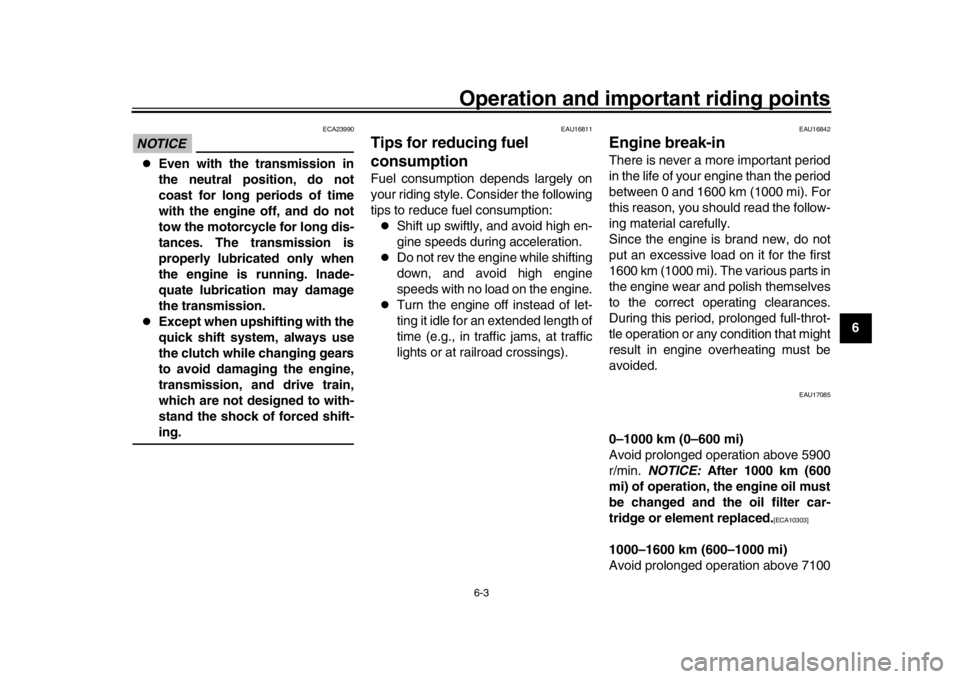
Operation and important riding points
6-3
1
2
3
4
567
8
9
10
11
12
NOTICE
ECA23990
Even with the transmission in
the neutral position, do not
coast for long periods of time
with the engine off, and do not
tow the motorcycle for long dis-
tances. The transmission is
properly lubricated only when
the engine is running. Inade-
quate lubrication may damage
the transmission.
Except when upshifting with the
quick shift system, always use
the clutch while changing gears
to avoid damaging the engine,
transmission, and drive train,
which are not designed to with-
stand the shock of forced shift-ing.
EAU16811
Tips for reducing fuel
consumptionFuel consumption depends largely on
your riding style. Consider the following
tips to reduce fuel consumption:
Shift up swiftly, and avoid high en-
gine speeds during acceleration.
Do not rev the engine while shifting
down, and avoid high engine
speeds with no load on the engine.
Turn the engine off instead of let-
ting it idle for an extended length of
time (e.g., in traffic jams, at traffic
lights or at railroad crossings).
EAU16842
Engine break-inThere is never a more important period
in the life of your engine than the period
between 0 and 1600 km (1000 mi). For
this reason, you should read the follow-
ing material carefully.
Since the engine is brand new, do not
put an excessive load on it for the first
1600 km (1000 mi). The various parts in
the engine wear and polish themselves
to the correct operating clearances.
During this period, prolonged full-throt-
tle operation or any condition that might
result in engine overheating must be
avoided.
EAU17085
0–1000 km (0–600 mi)
Avoid prolonged operation above 5900
r/min. NOTICE: After 1000 km (600
mi) of operation, the engine oil must
be changed and the oil filter car-
tridge or element replaced.
[ECA10303]
1000–1600 km (600–1000 mi)
Avoid prolonged operation above 7100
B67-9-E4.book 3 ページ 2019年7月19日 金曜日 午後4時23分